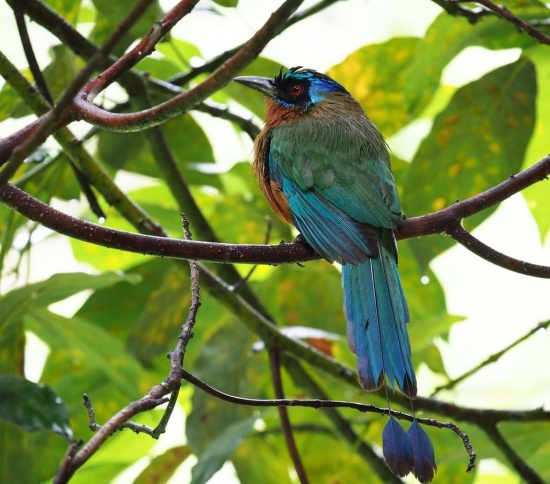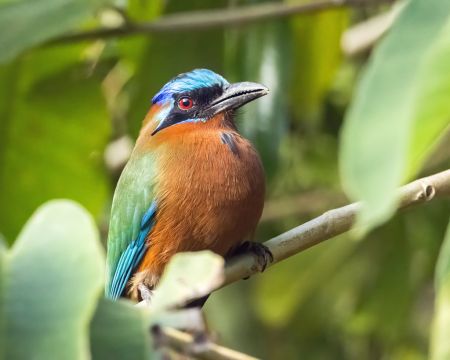(→Taxonomy: Update link) |
(Add photo) |
||
| (4 intermediate revisions by 3 users not shown) | |||
| Line 1: | Line 1: | ||
| − | [[Image: | + | [[Image:Image 37.jpg|thumb|550px|right|Photo © by {{user|RKA|RKA}} <br />Maraval, [[Trinidad]], August 2017]] |
| + | [[Image:2465 Motmot, Trinidad 01a.jpg|thumb|450px|right|Photo © by {{user|peterday|peterday}} <br />Cuffie River Nature Retreat, [[Tobago]], March 2024]] | ||
;[[: Category:Momotus|Momotus]] bahamensis | ;[[: Category:Momotus|Momotus]] bahamensis | ||
==Identification== | ==Identification== | ||
| − | + | 38–43 cm (15-17 in) <br /> | |
| − | Green upperparts , green or rufous underparts depending on subspecies (very variable how dark), black central spot on upper breast, black central crown surrounded by blue band, black | + | Green upperparts , green or rufous underparts depending on subspecies (very variable how dark), black central spot on upper breast, black central crown surrounded by blue band, black eye-mask sometimes edged pale at the back. |
| − | + | <br /> | |
Tail is green with blue lower tail with two longest feathers showing an area missing barbs followed by an area with barbs (rackets); the tip of these feathers is black in some subspecies. | Tail is green with blue lower tail with two longest feathers showing an area missing barbs followed by an area with barbs (rackets); the tip of these feathers is black in some subspecies. | ||
| − | + | <br /> | |
Notice that the tail feathers are normal when growing, the barbs fall off shortly after, and it is therefore possible to see a bird of this species that is missing rackets (feathers may also break below the rackets). | Notice that the tail feathers are normal when growing, the barbs fall off shortly after, and it is therefore possible to see a bird of this species that is missing rackets (feathers may also break below the rackets). | ||
| Line 13: | Line 14: | ||
Endemic to [[Trinidad]] and [[Tobago]] | Endemic to [[Trinidad]] and [[Tobago]] | ||
==Taxonomy== | ==Taxonomy== | ||
| − | There has been a recent split of a species known as Blue-crowned Motmot (''Momotus momota'') into | + | There has been a recent split of a species known as Blue-crowned Motmot (''Momotus momota'') into six species: |
| − | *[[Blue- | + | *[[Blue-capped Motmot]] (''M. coeruliceps'') -- from [[Mexico]] |
| − | *[[Whooping Motmot]] (''M. subrufescens'') -- from around the Canal zone in Panama to northern [[Colombia]] and northern [[Venezuela]] | + | *[[Lesson's Motmot]] (''M. lessoni'') -- from southern [[Mexico]] to western [[Panama]] |
| + | *[[Whooping Motmot]] (''M. subrufescens'') -- from around the Canal zone in Panama to northern [[Colombia]] and northern [[Venezuela]] as well as lowland western [[Ecuador]], and [[Peru]] | ||
*'''Trinidad Motmot''' (''M. bahamensis'') -- [[Trinidad]] and [[Tobago]] | *'''Trinidad Motmot''' (''M. bahamensis'') -- [[Trinidad]] and [[Tobago]] | ||
*[[Amazonian Motmot]] (''M. momota'') -- Amazonian lowlands from [[Colombia]], to The [[Guianas]] and south to [[Bolivia]] and [[Argentina]] | *[[Amazonian Motmot]] (''M. momota'') -- Amazonian lowlands from [[Colombia]], to The [[Guianas]] and south to [[Bolivia]] and [[Argentina]] | ||
*[[Andean Motmot]] (''M. aequatorialis'') -- Highlands in [[Colombia]], [[Ecuador]], and [[Peru]] | *[[Andean Motmot]] (''M. aequatorialis'') -- Highlands in [[Colombia]], [[Ecuador]], and [[Peru]] | ||
| − | + | <br /> | |
This is a [[Dictionary_M-O#M|monotypic]] species<sup>[[#References|[1]]]</sup>.<br /> | This is a [[Dictionary_M-O#M|monotypic]] species<sup>[[#References|[1]]]</sup>.<br /> | ||
It was formerly included in [[Blue-crowned Motmot]]. | It was formerly included in [[Blue-crowned Motmot]]. | ||
| Line 27: | Line 29: | ||
==Behaviour== | ==Behaviour== | ||
====Breeding==== | ====Breeding==== | ||
| − | + | They nest in tunnels in a bank. The clutch consists of 3-4 white eggs. | |
====Diet==== | ====Diet==== | ||
| − | The diet | + | The diet consists of insects, lizards and fruit. |
==References== | ==References== | ||
| − | #{{Ref- | + | #{{Ref-Clements6thAug16}}#F. Gary Stiles 2009. A REVIEW OF THE GENUS MOMOTUS (CORACIIFORMES: MOMOTIDAE) IN NORTHERN SOUTH AMERICA AND ADJACENT AREAS. [http://www.ornitologiacolombiana.org/oc8/Stiles.htm#1in Ornitología Colombiana No.8 (2009): 29-75]. Subject of Birdforum discussion [http://www.birdforum.net/showthread.php?p=1564833 here] |
{{ref}} | {{ref}} | ||
==External Links== | ==External Links== | ||
{{GSearch|Momotus+bahamensis}} | {{GSearch|Momotus+bahamensis}} | ||
[[Category:Birds]] [[Category:Momotus]] | [[Category:Birds]] [[Category:Momotus]] | ||
Latest revision as of 04:33, 27 April 2024
- Momotus bahamensis
Identification
38–43 cm (15-17 in)
Green upperparts , green or rufous underparts depending on subspecies (very variable how dark), black central spot on upper breast, black central crown surrounded by blue band, black eye-mask sometimes edged pale at the back.
Tail is green with blue lower tail with two longest feathers showing an area missing barbs followed by an area with barbs (rackets); the tip of these feathers is black in some subspecies.
Notice that the tail feathers are normal when growing, the barbs fall off shortly after, and it is therefore possible to see a bird of this species that is missing rackets (feathers may also break below the rackets).
Juvenile has reduced black on upper breast.
Distribution
Endemic to Trinidad and Tobago
Taxonomy
There has been a recent split of a species known as Blue-crowned Motmot (Momotus momota) into six species:
- Blue-capped Motmot (M. coeruliceps) -- from Mexico
- Lesson's Motmot (M. lessoni) -- from southern Mexico to western Panama
- Whooping Motmot (M. subrufescens) -- from around the Canal zone in Panama to northern Colombia and northern Venezuela as well as lowland western Ecuador, and Peru
- Trinidad Motmot (M. bahamensis) -- Trinidad and Tobago
- Amazonian Motmot (M. momota) -- Amazonian lowlands from Colombia, to The Guianas and south to Bolivia and Argentina
- Andean Motmot (M. aequatorialis) -- Highlands in Colombia, Ecuador, and Peru
This is a monotypic species[1].
It was formerly included in Blue-crowned Motmot.
Habitat
Habits near water, rivers, streams, and builds its nest in hollows excavated on banks. Likes to perch on branches in the shadow, inside forest, in hedgerows, or in scrub.
Behaviour
Breeding
They nest in tunnels in a bank. The clutch consists of 3-4 white eggs.
Diet
The diet consists of insects, lizards and fruit.
References
- Clements, J. F., T. S. Schulenberg, M. J. Iliff, D. Roberson, T. A. Fredericks, B. L. Sullivan, and C. L. Wood. 2016. The eBird/Clements checklist of birds of the world: v2016, with updates to August 2016. Downloaded from http://www.birds.cornell.edu/clementschecklist/download/
- F. Gary Stiles 2009. A REVIEW OF THE GENUS MOMOTUS (CORACIIFORMES: MOMOTIDAE) IN NORTHERN SOUTH AMERICA AND ADJACENT AREAS. Ornitología Colombiana No.8 (2009): 29-75. Subject of Birdforum discussion here
Recommended Citation
- BirdForum Opus contributors. (2024) Trinidad Motmot. In: BirdForum, the forum for wild birds and birding. Retrieved 29 May 2024 from https://www.birdforum.net/opus/Trinidad_Motmot





